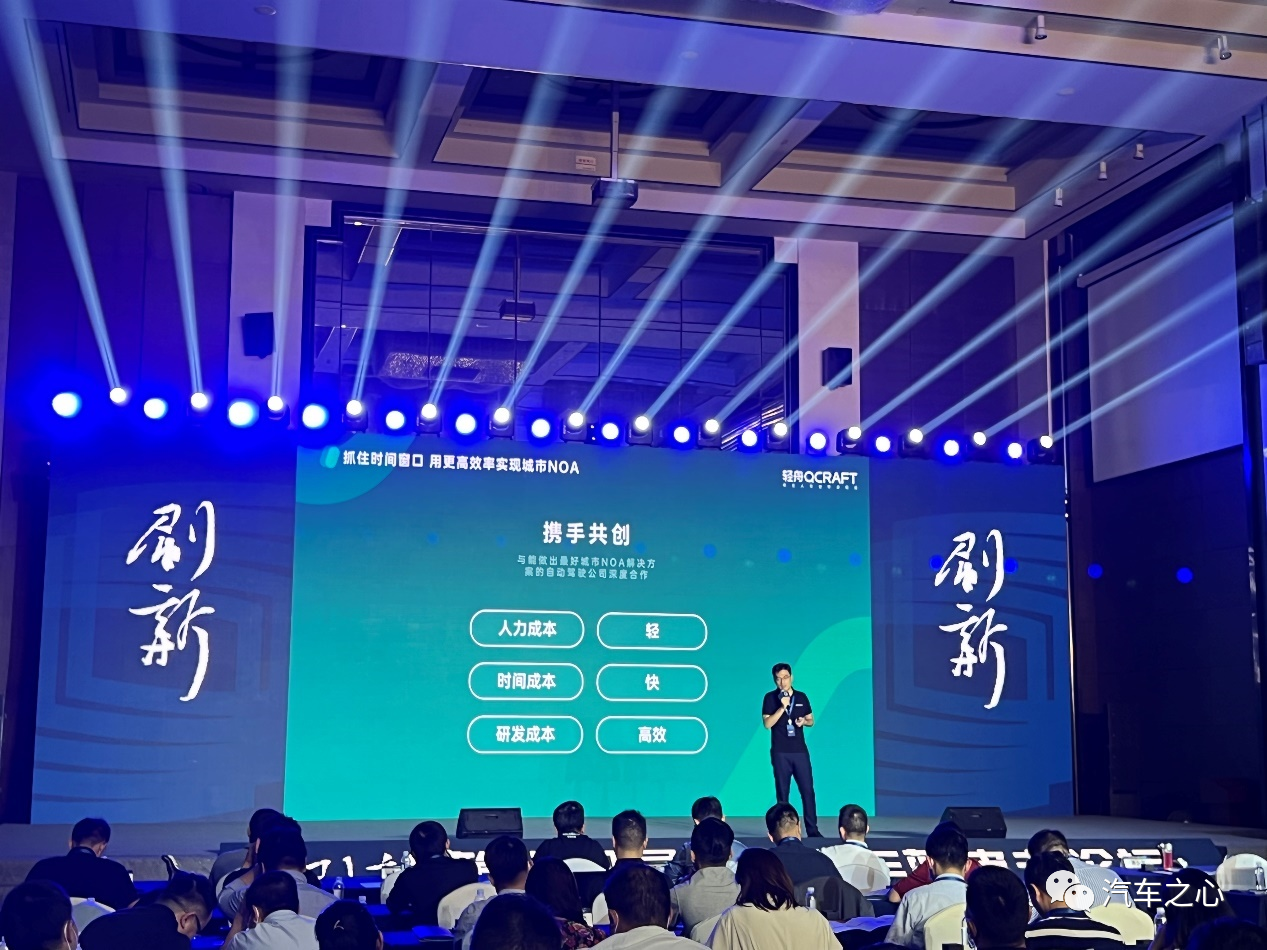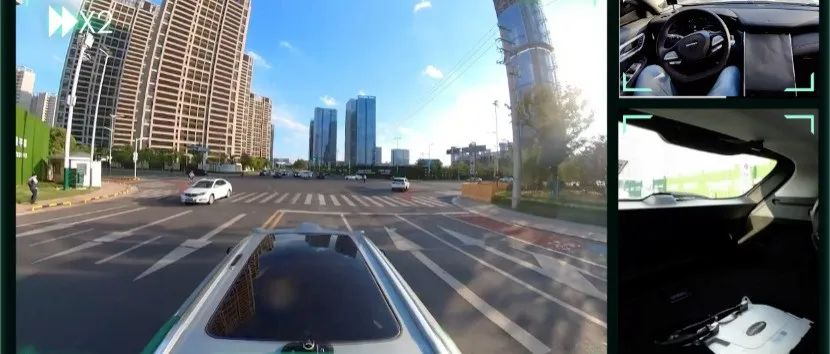How many solid-state LiDARs are needed to implement Urban NOA?
The answer given by L4 autonomous driving company, QZJH, is that even with only one solid-state LiDAR, combined with necessary vision perception cameras, it is achievable!
It has to be acknowledged that cost-controlled production of efficient Urban NOA has become the latest direction for all industry players to compete for.
Not long ago, CEO of Xpeng Motors, He XPeng, released a video of him experiencing Xpeng City NGP. During this video, Wu Xinzhou, Vice President of Xpeng’s Autonomous Driving, who was also a passenger, said, “The most painful part of doing city NGP is that there is no benchmark. We hope to benchmark directly with L4 company, using the cost of a mass-produced car to achieve L4-level experience.”
On July 8th, during the 14th China Automobile Blue Book Forum (CABF 2022), Yu Qian, co-founder and CEO of QZJH, was invited to speak. In response to the question, he humorously said, “To achieve Urban NOA at the L4 level with the cost of a mass-produced car is exactly what QZJH is doing.”
In fact, it has long been recognized in the industry that L4 companies have a significant advantage over L2/L2+ companies in doing Urban NOA, which is due to their stronger data loop ability, better system fluency, and higher performance ceiling.
Urban NOA + data loop, creating intelligent driving solutions that appeal to OEMs/consumers
CABF is an annual industry event of China’s auto sector and a hub for opinions and ideas of China’s auto industry. This year’s event, with a theme of “Refreshing”, has gathered executives, technical experts, analysts and investors from China’s leading OEMs, upstream and downstream companies of the industry chain, and industry institutions, to discuss the opportunities and challenges of the new development pattern of China’s new energy vehicle age.
As a frontier field of the automotive and technology industries, the application of intelligent driving technology is gradually expanding from simple high-speed scenarios to complex urban scenarios, leading market awareness and consumer demand.
Therefore, in addition to leading Chinese auto industry enterprises such as Dongfeng Motor, Xpeng Motors, and SAIC Motor, technology autonomous driving companies such as QZJH were also invited to attend this forum.As an L4 autonomous driving universal solution company, QZ Intelligent Navigation (QZ) has rapidly taken the lead in the commercial landing of Robobuses, and is continuously advancing the technological accumulation and commercial operation of Robotaxis, but we are not limited to this,” said Yu Qian, “QZ has always been thinking about what kind of solution can meet consumers’ and automakers’ expectations for intelligent driving. The answer to this question is the high-performance-cost city NOA solution combined with the powerful data closed-loop capability.”
Currently, most car companies and autonomous driving companies in the industry are only focusing on 10% of the high-speed scenarios. However, according to people’s driving mileage or time, 90% of the driving states are actually in urban areas.
Compared with high-speed scenarios, city scenarios face various complex road conditions. City NOA is designed to solve most of the difficult problems encountered by most people when driving in cities, including left turns without protection, narrow road access, pedestrian right-of-way, U-turns, automatic lane change and overtaking, automatic obstacle avoidance and autonomous roundabout crossing, and other advanced driving assistance features to help drivers shuttle more safely and efficiently on city roads.
Yu Qian believes that if an intelligent driving product can only be opened in 10% of scenarios, it obviously cannot meet consumers’ expectations. QZ has long been focused on the landing of NOA front-loading production solutions for 90% of city scenarios.
At the forum, Yu Qian demonstrated a video of QZ’s autonomous driving car flexibly dealing with various complex road conditions in urban scenarios. Many of them are extreme corner case scenarios.
Methodology of L4 Autonomous Driving Companies in Building City NOA
Building a good city NOA solution is not an easy task. Autonomous driving is a strongly technology-driven field, and must have a strong and systematic technical system as support.
Based on “data-driven” and “efficiency improvement,” QZ’s unique and highly effective methodology “Autonomous Driving Super Factory” is the foundation for QZ to create the best city NOA solution.Based on the methodology of “data-driven” and “efficiency improvement”, all technological advances of Light Ship Intelligence are developed around data-driven and efficiency improvement according to Yuan Qian.
Based on this methodology, Light Ship Intelligence’s perception system has achieved three efficiencies: “data efficiency”, “model efficiency” and “evaluation efficiency”, thus achieving the implementation of a large-scale perception solution in all scenarios.
Not only that, Light Ship Intelligence has also independently created the “space-time joint planning” technology in China.
Currently, the industry widely uses the “space-time separation planning” automatic driving solution, which has limited road adaptability and can easily cause poor experiences such as sudden braking. The Light Ship “space-time joint planning” system endows vehicles with a more sensitive ability to seize opportunities and can smoothly complete continuous obstacle avoidance in various complex road conditions, bringing passengers a smooth and bump-free comfortable riding experience.
Yuan Qian emphasized that “space-time joint planning” is the most suitable automatic driving technology for Chinese roads.
Based on the “automatic driving super factory” methodology, Light Ship Intelligence released the latest front-loaded mass production automatic driving solution DBQ V4 for the car rules in May.
“The DBQ V4 is designed specifically for city NOA, and its standard version can achieve city NOA with only one laser radar.”
Currently, there is still controversy in the industry about whether laser radar is necessary for city NOA, but Yuan Qian believes that laser radar is still necessary for city NOA in the next few years.
However, Light Ship Intelligence’s proposition is “no pile-up, but through high-cost-effective mass production plans that adjust randomly to meet the mass production needs of different automakers with different levels of automatic driving functions.
To this end, DBQ V4 provides standard versions, enhanced versions, flagship versions, and other configurations that can tailor functions under the support of one technology stack to achieve flexible configurations.
Promoting the mass production of city NOA, data-closed-loop capabilities are also extremely important, as it can allow intelligent vehicles to generate massive data “more and more useful, frequently updated” every day to achieve efficient iteration of technology.
Light Boat Matrix, an automatic driving research and development toolchain centered on simulation, is the key for Light Ship Intelligence to achieve data-closed-loop, as it opens up the entire process from data processing, labeling, training, large-scale simulation, and technology output, making technology iteration safer, more efficient, and more cost-effective.
This toolchain is currently open to the public, and is expected to help customers establish data-closed-loop capabilities.
Time is pressing and tasks are heavy.Since 2017, new forces in the automobile industry, represented by NIO, XPeng, and Li Auto, have actively pushed for the research and development of urban NOA. After 3-4 years, it has gradually been put into mass production and has been highly sought after by the market.
Many cutting-edge consumers who are keen to experience the most advanced products and technologies have already taken models with NOA functionality as an important consideration when making their vehicle selection. The reason why new forces in the automobile industry, such as NIO, XPeng, Li Auto, can quickly gain recognition from the vast majority of consumers is precisely because they take the lead in intelligentization and dare to break through.
Driven by these cutting-edge consumers, a wider range of following consumers are being inspired. “Intelligent driving” is gradually occupying more and more of consumers’ minds.
This trend has posed an “urgent and important” task to the entire automobile industry.
Yu Qian expressed that QZ Intelligent Navigation is willing to cooperate closely with a large number of original equipment manufacturers and upstream and downstream partners in the industry ecosystem to leverage its own advantages, help customers achieve “lighter, faster, and more efficient” results in terms of labor costs, time costs, and R&D costs, seize the time window, seize consumers’ minds, and rapidly advance the mass production and application of urban NOA.

At present, the entire automobile industry is undergoing another round of transformation from electrification to intelligentization, which has become a widely recognized industry consensus. With the rapid iteration of technology, sensors such as lidar are gradually approaching the level of vehicle specifications, and urban NOA has finally ushered in the “mass production era.”
However, the achievement of this goal is not accomplished overnight, but requires the cooperation and close integration of the entire industry.
In the face of this super-competitive era, we believe that in cooperation with L4 level autonomous driving companies such as QZ Intelligent Navigation, more and more original equipment manufacturers and industry partners will achieve win-win cooperation and jointly create high-performance and cost-effective urban NOA, truly bringing it into reality with higher efficiency.
This article is a translation by ChatGPT of a Chinese report from 42HOW. If you have any questions about it, please email bd@42how.com.
